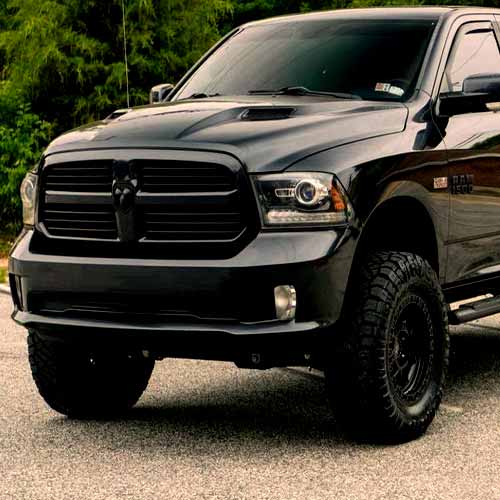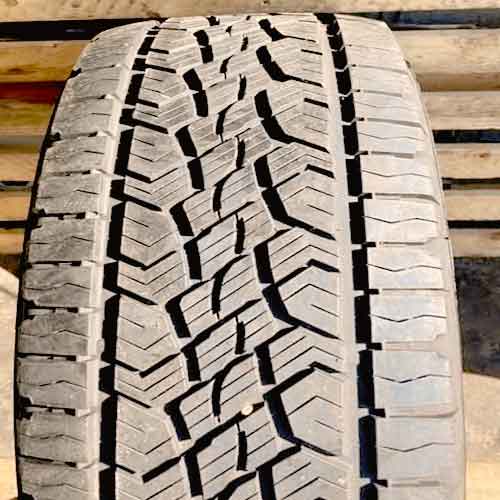All-terrain tires are designed for use in a wide range of off-road conditions while maintaining good comfort on paved roads. Compared to passenger tires, these tires generate more tread noise, which can be heard inside the vehicle as a humming or low-pitched sound.

It’s worth noting that the level of noise can vary depending on the specific all-terrain tire and the driving conditions.
Tires with a more aggressive tread pattern tend to be noisier. And tread wear further contributes a lot; that’s why these tires don’t age well in terms of providing a silent ride (if not rotated properly and frequently).
Factors Affecting Tread Noise
So, what causes larger noise production in these tires in the first place? Well, to understand that, let me first explain what tread noise is.
Noise is just unwanted sound waves generated by air particles hitting the tread and moving in and out of the grooves (mostly entering through the shoulder gaps).
So, tread pattern has a huge role to play here. Let me start with that.
Tread Pattern
All-terrain tires typically have more aggressive tread patterns than regular (passenger) tires. So, with larger tread blocks and deeper grooves, these tires have more space available for air to move around, which produces noise pollution.
Similarly, tread depth has a similar role to play here. Deeper tread voids again provide more area for the air to strike the walls of the tread with full force.
And worth reminding, with greater tread depth, these tires also tend to create more groove resonance as well, and it’s not helping the overall noise either.
Although all tires have pitch sequencing technologies (described below), they differ a lot from one another, where some are effective, while others are not able to dampen the noise levels properly.
Pitch sequencing occurs when various parts of the tread create different sound tones, and they cancel out each other, or at least try to. This is done by varying the geometry of the lugs from one another, in a very subtle way.
Tread compound
Tread composition also has a huge role to play in overall noise levels. Some tread compounds have higher silica density, which makes their structure elastic.
With an elastic compound, the grooves create an echo with the generated noise, and the bounced-off noise waves cause amplification, generating a wobbling sound in most cases.
This type of noise gets worse if tires are not balanced properly.
Sidewall construction
Most all-terrain tires come with reinforced sidewalls, making them harder to puncture, especially when driving on rougher tracks. These tires tend to be stiffer on the sides, while their middle part of the tread stays soft.
With this, a difference in pressure is created, so the air particles entering the grooves strike the middle part of the tread with greater force, generating noise.
Though this is mostly common with sidewalls having spirally wound nylon cap plies.
Shoulder design
All-terrain tires have more aggressive shoulder designs with wider grooves in between (compared to on-road tires). And as most of the air comes in/goes out through here, they become a major deciding factor in whether a tire will be silent or not.
That’s the reason why tires have ridges placed in between and some tires like Cooper have Whisper Groove Technology doing the same, restricting noise from getting in.
You can check it out on Cooper AT3 4S(review): https://tiredriver.com/cooper-at3-4s-review/
Tire’s Weight
The heavier the tire, the more friction it creates with the road, and more noise is generated. This happens because the rubber tends to flex more with extra mass while rolling.
And with more flexing, larger in-groove resonance is generated.
For Your Info: With this bending of the lugs, all-terrain tires also give out worse gas mileage as well, of course compared to on-road tires.
Quietest All-Terrain Tire
The Continental TerrainContact A/T (review), from my perspective as a tire engineer, is the quietest all-terrain tire. Let me explain why.

On roads, although noise is generated with rolling and surface texture differences, most of it comes from air.
All the grooves that you see on the tire have air in them, and as the tire rolls, that air starts pumping in and out of the tread, generating noise in two ways.
One, in the form of whistling, going out and coming in through shoulder blocks, and two, by hitting around through the tread.
And this tire deals with both in a beautiful way.
If you consider its shoulder lugs, you’d note that they are very packed together. There are very few gaps in between and even those small ones have ridges. This restricts the air from coming in in the first place.
And the little air that does manage to get in is dealt with by pitch sequencing, which you may have heard of as variable pitch technology.
TerrainContact A/T basically has a very well-engineered design where its lugs vary in shape throughout the tread. This way air particles hitting different parts of the tread create different frequencies. And they then try to cancel out each other, allowing this tire to become even quieter than some of the on-road tires out there.
I ranked this tire for it in my list of best all-terrain tires: https://tiredriver.com/best-all-terrain-tires/
Conclusion
So, to sum up, although all-terrain tires are notorious for being loud on roads, there are some on-road-oriented tires that are better.
That’s because with an aggressive design, tires having wider grooves and deeper tread voids allow more air to come in through the shoulder gaps and hit around the tread, generating noise.
Moreover, some tires have stiffer shoulder lugs, due to the spirally wound inner plies, and these encourage air particles to hit (especially in the middle part of the tread) with full force, generating unwanted sound waves.